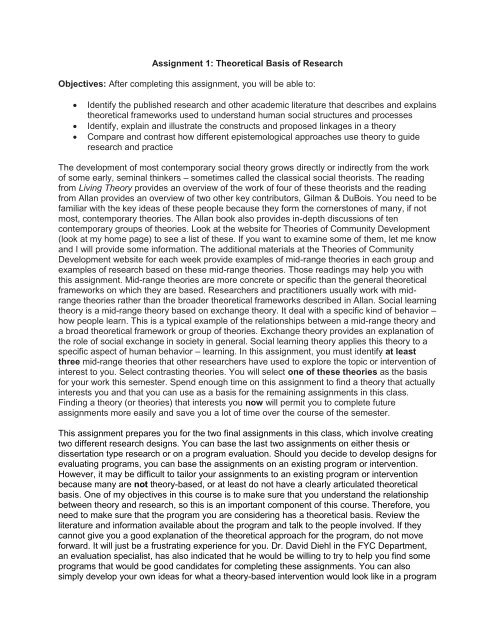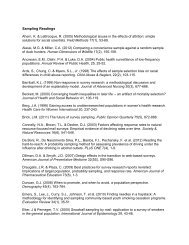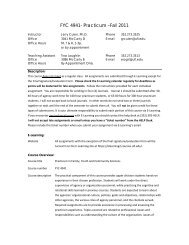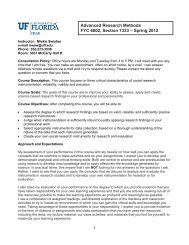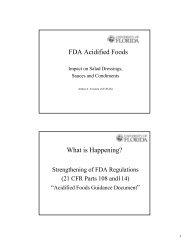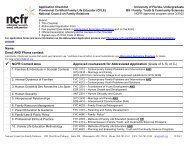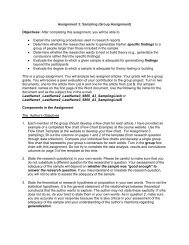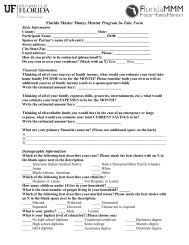Assignment 1: Theoretical Basis of Research Objectives: After ...
Assignment 1: Theoretical Basis of Research Objectives: After ...
Assignment 1: Theoretical Basis of Research Objectives: After ...
Create successful ePaper yourself
Turn your PDF publications into a flip-book with our unique Google optimized e-Paper software.
designed to address the need, problem or issue that you identify in <strong>Assignment</strong> 3. If you doelect to take an evaluative stance for your work, you need to identify the program or interventionbefore completing <strong>Assignment</strong> 3 so that you can select theories that are relevant to the programyou have selected.Use published research reports, “think” pieces, research reviews, textbooks, and otheracademic sources to learn about mid-range social theories. <strong>Research</strong> reviews will beespecially useful. I have included a Guide to Reading <strong>Research</strong> Reviews at the web site. Istrongly encourage you to use this guide, which is similar to those for reading research reports,as you complete this assignment.Make sure that you do not confuse a concept or construct like social capital or personality typewith a theory. See pages 69-74 <strong>of</strong> Crix, for example, for a discussion <strong>of</strong> social capital. It is aconstruct in several theories, but it is not a theory.Do not pick a topic (like child abuse or community-based conservation). Theories are not abouttopics. They are about human behaviors, social processes and social structures, and the sametheory will provide a basis for understanding behaviors, structures and processes in manydifferent settings, with reference to many different topics, or with regard to many differentsituations. For example, the theory <strong>of</strong> planned behavior is equally useful for understandingwomen’s decisions about breast-feeding, youths’ decisions about joining gangs, and collegestudents’ decisions about what major to select. There is no theory <strong>of</strong> “deciding to smoke.” Thereare several theories <strong>of</strong> decision making that can help us understand the decision-makingprocess in general, including the decision to smoke. Do not pick one <strong>of</strong> the grand theories.Do consult, use, cite and reference additional materials about research design beyond therequired readings in responding to this assignment. Using resources about research designbeyond those that we cover in class in these assignments is an important course requirement. Iam giving you one perspective. The published literature about the topics that we cover in thisclass will provide you with additional perspectives and with a greater depth <strong>of</strong> understanding <strong>of</strong>the topics that we cover. In this assignment, for example, you may want to look at additionalliterature that discusses the role <strong>of</strong> theory in scientific research and the literature that deals withthe relationship between epistemology and the role <strong>of</strong> theory in research. I have tried to helpyou with this requirement for this assignment.I have provided three kinds <strong>of</strong> materials that may be <strong>of</strong> use in meeting the evaluation criteria(listed below) for this assignment. On the web page for this week you will find lists <strong>of</strong>: (1)appropriate articles that discuss the role <strong>of</strong> theory and epistemology in research, (2) examples<strong>of</strong> research reports that have a good theoretical basis, and (3) examples <strong>of</strong> articles that studentsin the past have found very useful in seeing how theory is used to guide research.Answer the questions below. Number your response to each question. Include an explanation orjustification for each answer. Be specific in your answers. Use the following as the file name forthe Word document: YourLastName_6800_A1_Theory1. Most research, including theory-based research, grows out <strong>of</strong> the researcher’s desire tosolve a problem, issue or need or provide knowledge needed by practitioners. What problemor need for knowledge do you want to address? One <strong>of</strong> my students was concerned withhow we can get people to behave in more environmentally responsible ways. Providejustification that the problem is a significant one that merits attention. Use the publishedliterature to document the extent and seriousness <strong>of</strong> the problem. (1/2 page maximum)
2. Identify and list at least three theories that other researchers and practitioners have usedto address this problem. Summarize the key constructs in each theory and the linkagesbetween them for each theory. (1.5 page maximum for all three theories)3. Provide examples from the scholarly literature <strong>of</strong> how people have used each theory toinform research and practice relevant to the need, issue or problem you have identified.Consult, cite and reference at least five sources <strong>of</strong> information for each theory. At least two<strong>of</strong> the five must be research reports. (6 page maximum)4. Compare and contrast the strengths and weaknesses <strong>of</strong> the three theories for exploring theproblem or need you have identified. For example, assume your topic is binge drinking bycollege students. You could explore the theory <strong>of</strong> planned behavior, the social influence andinterpersonal communication model, and the social networks model to try to understand whycollege students engage in this behavior. You might decide that the theory <strong>of</strong> plannedbehavior has a drawback because it does not include peer interaction (although it doesinclude peer norms) as a construct. This is quite different from both the social influence andsocial network models, which do include peer interaction. (3 page maximum)5. Select at least one theory to serve as the basis for your work this semester. Justify yourdecision about which theory you will use. Base your justification on (1) the strengths andweaknesses discussed previously and (2) the potential for adding to the body <strong>of</strong> knowledgeand/or improving evidence based practice through research based on the selected theory.For example, you might select a theory because little research has been based on thetheory or, on the contrary, because previous research has demonstrated that the theory<strong>of</strong>fers a robust explanation <strong>of</strong> the phenomenon <strong>of</strong> interest to you. Alternatively, you mightselect a theory because you want to better define the range <strong>of</strong> conditions (domain) underwhich the theory provides good explanatory power. Make sure you use the literature aboutthe role <strong>of</strong> theory in research to justify your choice. (0.5 page maximum)6. Summarize in your own words the key concepts or constructs in a table format. See theexample below <strong>of</strong> the theory <strong>of</strong> planned behavior. I recommend that you complete the steps6 and 7 for the all three theories because you may decide to compare and contrast twotheories or to extend “your” theory by combining constructs from other theories into it as youdevelop your actual research designs. For example, you might decide that the theory <strong>of</strong>planned behavior is a “good” one for your problem or need, but feel that it has shortcomingsbecause it does not include any aspect <strong>of</strong> social exchange. You might therefore decide inyour research to “add” a social exchange component to this theory. Submit only the theoryyou have selected. Be precise in your definitions and make sure you cite the literature fromwhich you derived the definitions. (1 page maximum)7. Draw a conceptual map (diagram) <strong>of</strong> the theory (or theories). You can submit a scannedhand-drawn document if necessary. See the example <strong>of</strong> the theory <strong>of</strong> planned behavior.More detail is better than little detail. (1 page max)Assessment CriteriaPossiblePointsFollowed instructions, including using APA style 5Used published research literature to identify three conceptually distinct 15mid-range theories <strong>of</strong> relevance to the problem or need (for example, thetheory <strong>of</strong> planned behavior and the theory <strong>of</strong> reasoned action are notYourPoints
conceptually distinct); summarized in your own words the key ideas inthe theory and the explanatory framework each theory proposesConsulted, cited and referenced academic literature, including research 20reports, showing how the three mid-range theories have been used toinform practice and research about your topic <strong>of</strong> interest; demonstratedfamiliarity with the body <strong>of</strong> practice and research associated with eachtheory;Selected one theory to use this semester; provided a robust justification, 30based on the research literature reviewed, literature about the role <strong>of</strong>theory in research design, key concepts discussed in this class about thenature <strong>of</strong> scientific knowledge and the scientific research process;addressed why the theory selected provides a significant opportunity toadd to the body <strong>of</strong> knowledge about the phenomenon <strong>of</strong> interest, informpractice, and add to our theory-based understanding <strong>of</strong> the phenomenon <strong>of</strong>interestProvided a definition <strong>of</strong> each major construct in one <strong>of</strong> these theories and a 30detailed conceptual map <strong>of</strong> the major constructs and relationships betweenthem; cited and referenced the research literature used to develop thedefinitions and conceptual mapTotal 100Theory <strong>of</strong> Planned BehaviorBehavioralbeliefsEvaluation <strong>of</strong>behavioraloutcomesAttitude towardbehaviorNormativebeliefsMotivation tocomplySubjective normBehavioralintentionControl beliefsPerceived powerPerceivedbehavioralcontrolBEHAVIOR
SummativeConstructsAttitude towardbehaviorSubjective normPerceivedbehavioral controlBehavioralintentionBehaviorPrimaryConstructs orDimensions orComponents inthe SummaryConstructBehavioral beliefEvaluationNormative beliefMotivation tocomplyControl BeliefsPerceived PowerDefinitionOverall evaluation <strong>of</strong> the behaviorBelief that behavioral performance is associated withcertain attributes or outcomesValue attached to a behavioral outcome or attributeBelief about whether most people approve ordisapprove <strong>of</strong> the behaviorBelief about whether each referent approves ordisapproves <strong>of</strong> the behaviorMotivation to do what each referent thinksOverall measure <strong>of</strong> perceived control over the behaviorPerceived likelihood <strong>of</strong> occurrence <strong>of</strong> each facilitatingor constraining conditionPerceived effect <strong>of</strong> each condition in making behavioralperformance difficult or easyPerceived likelihood <strong>of</strong> performing the behaviorActual observed or reported behavior


